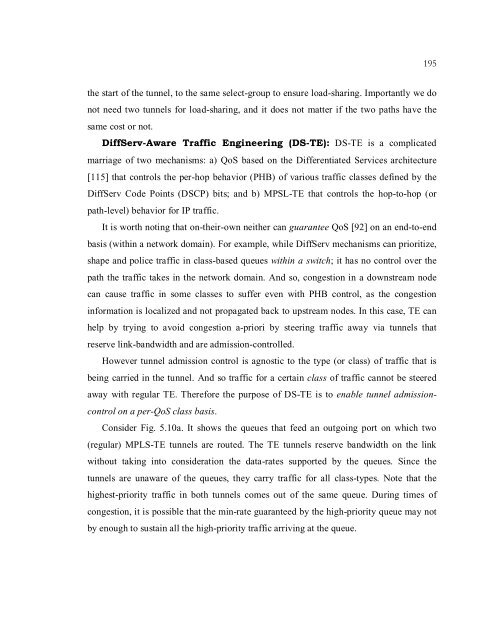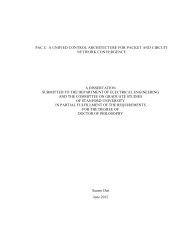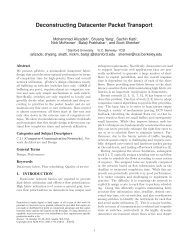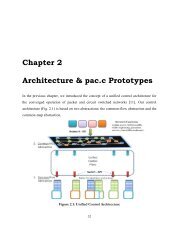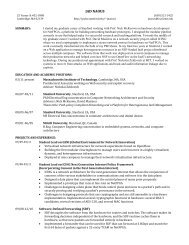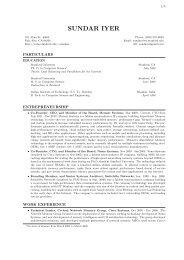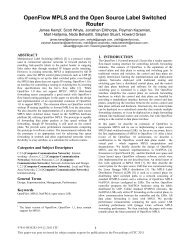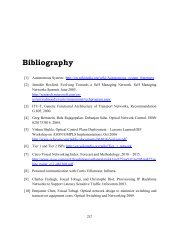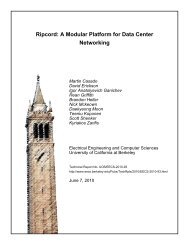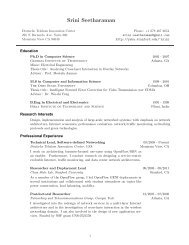Chapter 5 Introducing SDN Control in MPLS Networks - High ...
Chapter 5 Introducing SDN Control in MPLS Networks - High ...
Chapter 5 Introducing SDN Control in MPLS Networks - High ...
Create successful ePaper yourself
Turn your PDF publications into a flip-book with our unique Google optimized e-Paper software.
195the start of the tunnel, to the same select-group to ensure load-shar<strong>in</strong>g. Importantly we donot need two tunnels for load-shar<strong>in</strong>g, and it does not matter if the two paths have thesame cost or not.DiffServ-Aware Traffic Eng<strong>in</strong>eer<strong>in</strong>g (DS-TE): DS-TE is a complicatedmarriage of two mechanisms: a) QoS based on the Differentiated Services architecture[115] that controls the per-hop behavior (PHB) of various traffic classes def<strong>in</strong>ed by theDiffServ Code Po<strong>in</strong>ts (DSCP) bits; and b) MPSL-TE that controls the hop-to-hop (orpath-level) behavior for IP traffic.It is worth not<strong>in</strong>g that on-their-own neither can guarantee QoS [92] on an end-to-endbasis (with<strong>in</strong> a network doma<strong>in</strong>). For example, while DiffServ mechanisms can prioritize,shape and police traffic <strong>in</strong> class-based queues with<strong>in</strong> a switch; it has no control over thepath the traffic takes <strong>in</strong> the network doma<strong>in</strong>. And so, congestion <strong>in</strong> a downstream nodecan cause traffic <strong>in</strong> some classes to suffer even with PHB control, as the congestion<strong>in</strong>formation is localized and not propagated back to upstream nodes. In this case, TE canhelp by try<strong>in</strong>g to avoid congestion a-priori by steer<strong>in</strong>g traffic away via tunnels thatreserve l<strong>in</strong>k-bandwidth and are admission-controlled.However tunnel admission control is agnostic to the type (or class) of traffic that isbe<strong>in</strong>g carried <strong>in</strong> the tunnel. And so traffic for a certa<strong>in</strong> class of traffic cannot be steeredaway with regular TE. Therefore the purpose of DS-TE is to enable tunnel admissioncontrolon a per-QoS class basis.Consider Fig. 5.10a. It shows the queues that feed an outgo<strong>in</strong>g port on which two(regular) <strong>MPLS</strong>-TE tunnels are routed. The TE tunnels reserve bandwidth on the l<strong>in</strong>kwithout tak<strong>in</strong>g <strong>in</strong>to consideration the data-rates supported by the queues. S<strong>in</strong>ce thetunnels are unaware of the queues, they carry traffic for all class-types. Note that thehighest-priority traffic <strong>in</strong> both tunnels comes out of the same queue. Dur<strong>in</strong>g times ofcongestion, it is possible that the m<strong>in</strong>-rate guaranteed by the high-priority queue may notby enough to susta<strong>in</strong> all the high-priority traffic arriv<strong>in</strong>g at the queue.


